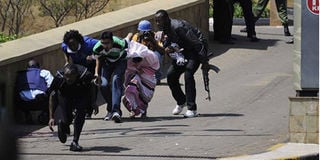
A policeman carries a baby to safety as he escorts members of the public out of Westgate Mall during the terror attack of September 21, 2013.
Esther Muiruri writes to express her concern regarding a photo published in the Daily Nation of March 13, 2024.
The image shows construction workers carrying the bloodied body of their colleague who was crushed to death by a falling lift. She finds the image, which was prominently displayed on page 23, deeply distressing and harmful.
She acknowledges the use of photos to expose safety issues and construction incidents across the country as good journalism.
But she strongly believes this photo shouldn’t have been used without some form of blurring or censorship.
The image has the potential to emotionally harm the family of the deceased and disturb other viewers including young persons.
The graphic image could also offend individuals who may not have the fortitude to view such a disturbing image.
Shocked and distressed
The photo features a head that appears to be severely crushed, wrapped in what seems to be polythene paper or cling film.
Ms Muiruri suggests the lack of blurring is a failure on the part of the Nation to protect the sensitivities of its diverse readership. Her detailed response to the graphic mage appears alongside this commentary.
As she acknowledges, the photographer, Kevin Odit, did a good job capturing the solemnity of the moment. But his role ended there.
While photographers determine how to capture an image it is the editor who decides when and how to publish the image.
“There ought to have been an editor somewhere to ensure that the photo was blurred before being released to the public,” she says.
“As you are aware, newspapers are read by persons of all ages and dispositions. We cannot all be expected to have the fortitude to see such a photo and not be shocked and distressed by it.”
Disturbing pictures
The publication of graphic images is considered unethical. However, in exceptional cases, their publication has been justified because they changed public opinion or policy.
Example: The publication of images of a dead American soldier being dragged through the streets of Mogadishu in 1993. The image by photojournalist Paul Watson – it won him the Pulitzer prize – influenced President Bill Clinton’s decision to pull US troops out of Somalia.
In Kenya, the Code of Conduct for the Practice of Journalism requires the media to avoid publishing pictures of grief and disaster and those that “could possibly harm the persons concerned.”
The NMG editorial policy requires editors to avoid publishing photos that show dead or mutilated bodies, as well as photos of bloody incidents and abhorrent scenes, unless the publication of such photos “will serve the larger public interest.”
Disturbing images are rare in NMG platforms. I can recall only two in a decade or so. On June 18, 2022, NTV screened footage depicting an M-Pesa shop attendant, Sophia Gathoni, being shot dead by a robber. News anchor Zainab Ismail, however, warned viewers “the pictures may be disturbing”.
On September 22, 2013, the Sunday Nation published a photo of a victim of the Al-Shabaab terrorist attack on Nairobi’s Westgate shopping mall. The newspaper splashed the close-up image of the bloodied and dying woman on the front page. NMG apologised for the “poor judgment”.
Avoid graphic images
The media claim they use graphic images to convey the reality of a news event.
When the Media Council of Kenya questioned The New York Times for publishing bloody images of people killed during the January 15, 2019, terrorist attack on DusitD2 hotel in Nairobi, the newspaper retorted: “(We) believe it is important to give our readers a clear picture of the horror of an attack like this.”
Freedom of the media of course allows them to report news freely. But ethical and responsible journalism require them to balance between informing the public and respecting the dignity and privacy of those involved and avoiding harm to the emotional health of their loved ones, as well as respecting the sensitivities of diverse members of the public.
It is therefore customary for the media to avoid graphic images depicting violence, blood and death. In general, editors use such images only when their newsworthiness outweigh the emotional harm they do to viewers.
Even then, it’s common practice to blur or pixelate the graphic images. Blurring helps to reduce their distressing impact on viewers without compromising the intended message of the images.
The Public Editor is an independent news ombudsman who handles readers’ complaints on editorial matters including accuracy and journalistic standards. Email: [email protected]. Call or text 0721989264







